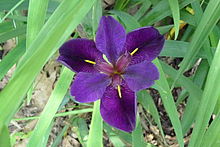| Louisiana iris | |
|---|---|

| |
| "Black Gamecock", a popular Louisiana iris cultivar | |
| Scientific classification | |
| Kingdom: | Plantae |
| Clade: | Tracheophytes |
| Clade: | Angiosperms |
| Clade: | Monocots |
| Order: | Asparagales |
| Family: | Iridaceae |
| Genus: | Iris |
| Subgenus: | Iris subg. Limniris |
| Section: | Iris sect. Limniris |
| Series: | Iris ser. Hexagonae |
| Species | |
Louisiana iris is a taxonomic group (Iris ser. Hexagonae) of five iris species native to Louisiana and surrounding regions of the southeastern United States: Iris fulva, Iris hexagona, Iris brevicaulis, Iris giganticaerulea, and Iris nelsonii.[1]
Each recognized species has noticeable phenotypic and habitat differences, yet similarities between their phenotypes and habitats can be drawn. These similarities are partially a result of their similar phylogenies. Many of the species are closely related, some a result of interbreeding, as in the most recent discovery of the Abbeville Red Iris, Iris nelsonii.[1] The five Louisiana irises are often categorized as "The Reds" or "The Blues" according to their corolla color. "The Blues", species Iris brevicaulis, Iris hexagona, and Iris giganticaerulea, typically have blue-purple corollas, with rare white forms.[1] "The Reds", species Iris fulva and Iris nelsonii, typically have red-orange corollas, with rare yellow forms.[1] Between 1920s and 1930s, Dr. John K. Small extensively studied irises in both Florida and Louisiana and named over 80 new species, including Iris savannarum, Iris kimballiae, Iris albispiritus and Iris rivularis.[2] Subsequent research has determined that only Iris savannarum is a true species and the others are synonyms of it.[3]
In 1990, the Louisiana iris was voted the state wildflower of Louisiana.[4] The state flower is the magnolia blossom.[5]

- ^ a b c d Cite error: The named reference
zydecowas invoked but never defined (see the help page). - ^ "A Gallery of Florida Irises". zydecoirises.com. Retrieved 28 November 2014.
- ^ "Iris savannarum Small is an accepted name". theplantlist.org. 23 February 2012. Retrieved 28 November 2014.
- ^ Cite error: The named reference
Seidenbergwas invoked but never defined (see the help page). - ^ "Louisiana State Wildflower". statesymbolsusa.org. Retrieved 28 November 2014.